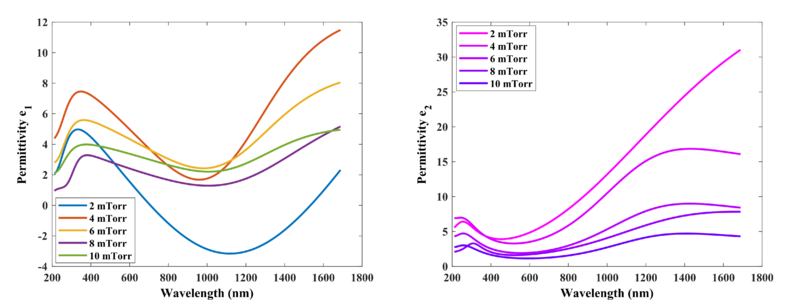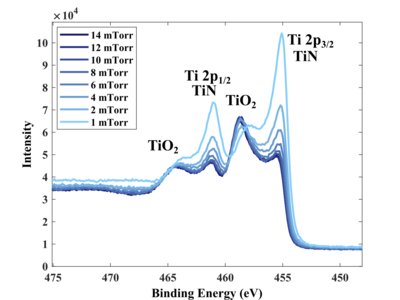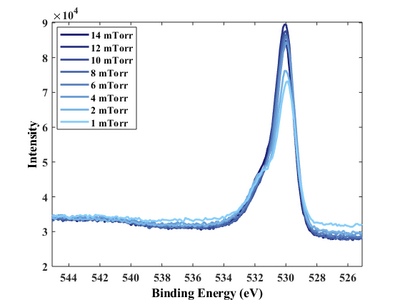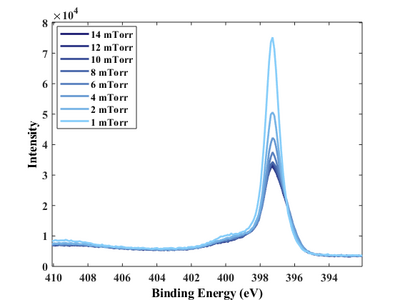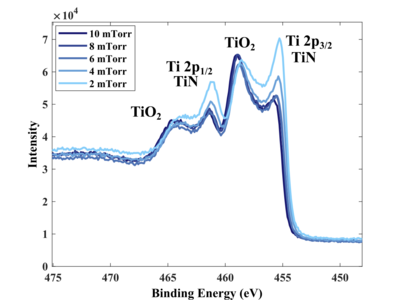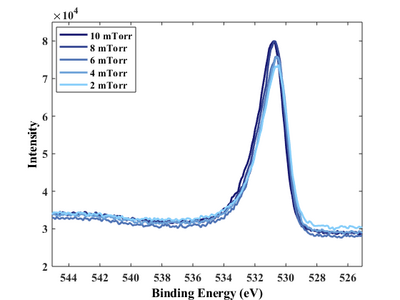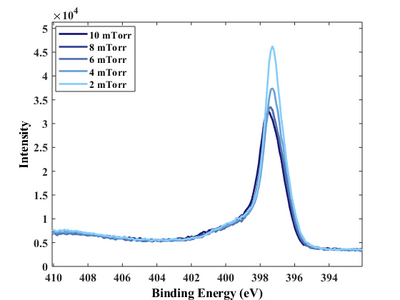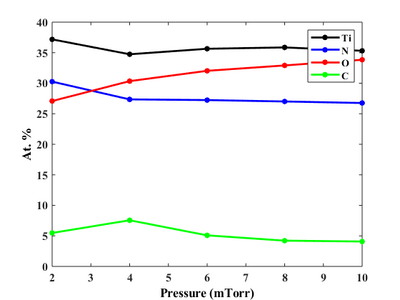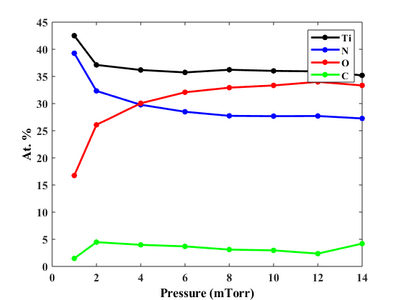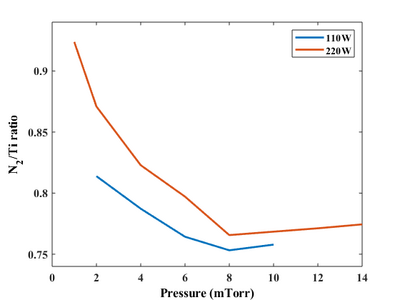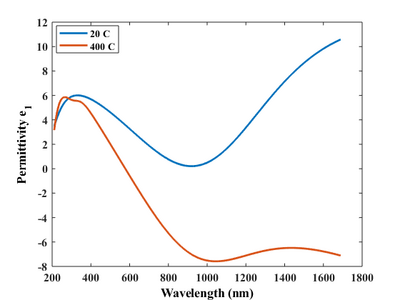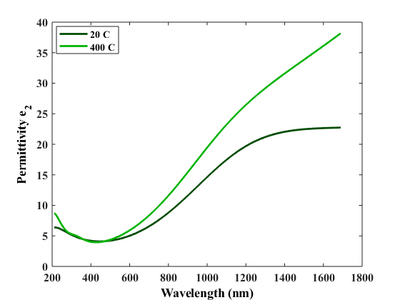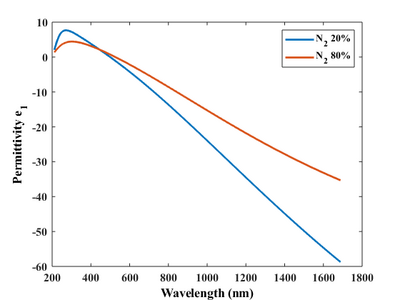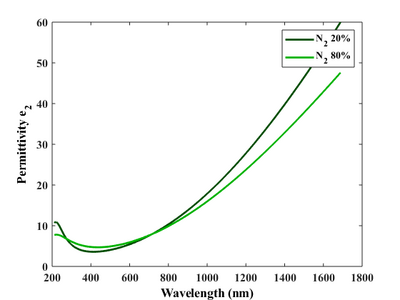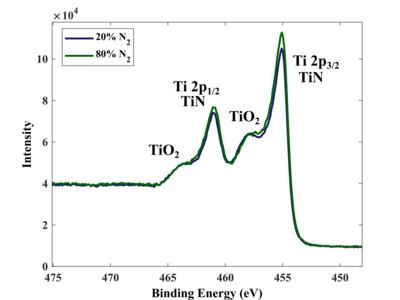Specific Process Knowledge/Thin film deposition/Deposition of Titanium Nitride/Deposition of Titanium Nitride using Lesker sputter tool: Difference between revisions
No edit summary |
|||
| Line 593: | Line 593: | ||
</gallery> | </gallery> | ||
==Stochiometry and N/Ti ratio== | ==Stochiometry and N<sub>2</sub>/Ti ratio== | ||
| Line 601: | Line 601: | ||
image:eves_20200407_TiN_lesker_NTi_ratio.png| N/Ti ratio for 220W and 110W deposition power. | image:eves_20200407_TiN_lesker_NTi_ratio.png| N/Ti ratio for 220W and 110W deposition power. | ||
</gallery> | </gallery> | ||
==Films elemental composition== | ==Films elemental composition== | ||
Revision as of 13:15, 15 April 2020
Deposition Characteristics
This page presents the results of TiN deposition using reactive sputtering by Lesker sputter tool. The fabrication and characterization was conducted in 2019 by Evgeniy Shkondin, DTU Nanolab. The prepared samples were investigated by X-ray Photoelectron Spectroscopy (XPS) and Spectroscopic Ellipsometry. Several parameters influens the quality of the films. The analysis included variations of power, pressure, substrate temperature and N2/Ar ratio.
In short, the key to prepare high quality, stochiometric, conducting TiN layers is to apply following deposition parameters:
- High power in the range 220W-250W
Lesker sputter tool uses 2-inch targets. For Ti source, the highest allowed power is 250W. Deposition rate increases by using high power and it lower incorporation of oxygen in the film.
- Low pressure (1-2 mTorr)
Lowering the pressure improves stochiometry and lower the oxygen content.
- High substrate temperature (400°C)
Generally, the substrat temperatre affects the density.
- Work with N2 concentration in the range 20-50%
The higher the nitrogen concentration the lower the deposition rate, and it will result issues in respect to oxygen contamination.
The investigation is mainly based on two powers - 110W and 220W in pressure range between 1 to 14 mTorr. Substrate temperature was kept at 400°C with N2/Ar ratio 20/80%.
Spectroscopic Ellipsometry
Drude-Lorentz model
Drude-Lorentz is commonly used to fit TiN complex dielectric function.
where:
is a high-frequency dielectric constant.
The Drude term can be written as follow:
where:
- dielectric permittivity of vacuum,
- Planck constant,
- resistivity,
- scattering time.
Lorentz oscillator term is given by:
where:
- number of oscillator,
- Amplitude,
- Broadening of each oscillator,
- Center energy of the Lorentz oscillator.
Dielectric function analysis
| High Power. Deposition time: 20min | Drude term | Lorentz oscillator - 1 | Lorentz oscillator - 2 | Lorentz oscillator - 3 | ||||||||||
|---|---|---|---|---|---|---|---|---|---|---|---|---|---|---|
| Power (W) | Pressure (mTorr) | Thickness (nm) | (Ohm cm) | (fs) | (eV) | (eV) | (eV) | (eV) | (eV) | (eV) | ||||
| 220 | 1 | 87.01 | 3.489 | 7.5618·10-5 | 1.008 | 192.557054 | 0.0213 | 6.321 | 9.689831 | 2.7132 | 5.604 | - | - | - |
| 220 | 2 | 66.13 | 2.609 | 2.017·10-4 | 1.141 | 2.083940 | 0.8848 | 3.492 | 8.125820 | 3.2412 | 5.944 | 15.781023 | 0.9923 | 1.053 |
| 220 | 4 | 66.40 | 1.934 | 6.6567·10-4 | 1.041 | 2.439534 | 1.3777 | 3.724 | 4.677488 | 4.0837 | 6.160 | 12.110575 | 0.9458 | 0.959 |
| 220 | 6 | 75.11 | 1.347 | 2.587·10-3 | 0.655 | 2.303432 | 1.7123 | 3.942 | 1.934678 | 5.4051 | 6.420 | 7.712139 | 0.9659 | 0.883 |
| 220 | 8 | 81.94 | 1.271 | 4.273·10-3 | 0.242 | 2.038004 | 1.7074 | 4.062 | 1.614453 | 5.6564 | 6.677 | 5.212949 | 0.8602 | 0.895 |
| 220 | 10 | 82.59 | 1.138 | 5.257·10-3 | 0.323 | 1.672949 | 1.6265 | 4.186 | 1.433617 | 7.9416 | 7.058 | 4.294563 | 0.8546 | 0.902 |
| 220 | 12 | 82.40 | 1.090 | 5.807·10-3 | 0.443 | 1.450316 | 1.5414 | 4.262 | 1.368362 | 9.1405 | 7.128 | 3.787770 | 0.8471 | 0.906 |
| 220 | 14 | 81.88 | 1.089 | 5.838·10-3 | 0.468 | 1.415215 | 1.5370 | 4.266 | 1.349390 | 9.2650 | 7.074 | 3.579245 | 0.8420 | 0.909 |
| Low Power. Deposition time: 40min | Drude term | Lorentz oscillator - 1 | Lorentz oscillator - 2 | Lorentz oscillator - 3 | ||||||||||
| Power (W) | Pressure (mTorr) | Thickness (nm) | (Ohm cm) | (fs) | (eV) | (eV) | (eV) | (eV) | (eV) | (eV) | ||||
| 110 | 2 | 37.28 | 1.951 | 3.4619·10-4 | 0.719 | 2.294032 | 2.7712 | 4.298 | 8.807626 | 4.6007 | 7.311 | 14.494131 | 1.0222 | 1.025 |
| 110 | 4 | 32.42 | 2.024 | 9.724·10-4 | 0.890 | 5.185267 | 3.5747 | 4.958 | 7.900142 | 2.2325 | 7.115 | 12.284271 | 0.8444 | 1.012 |
| 110 | 6 | 34.12 | 1.907 | 2.109·10-3 | 1.119 | 3.946173 | 3.4395 | 4.953 | 4.368733 | 1.9486 | 7.189 | 7.063107 | 0.8046 | 0.983 |
| 110 | 8 | 35.58 | 1.694 | 2.661·10-3 | 1.292 | 2.990718 | 3.3861 | 4.928 | 3.091825 | 2.0160 | 7.163 | 4.843337 | 0.7813 | 0.980 |
| 110 | 10 | 37.02 | 1.526 | 2.741·10-3 | 1.592 | 2.521075 | 3.5788 | 4.959 | 2.664635 | 2.1239 | 7.295 | 3.751751 | 0.7497 | 0.975 |
Dielectric function can be rearranged in order to separate real and complex parts: . Here, is a real part of the permittivity, and is imaginary part describing optical losses.
DC power 220W
- DC Power 220W
-
Elemental procent presence as a function of process pressure (110W).
DC power 110W
- DC Power 110W
-
Elemental procent presence as a function of process pressure (110W).
XPS analysis
XPS measurements of all samples has been performed using ….
High resolution scans of individual elements
DC power 220W
- DC Power 220W
-
Ti 2p scan.
-
O 1s scan.
-
N 1s scan.
DC power 110W
- DC Power 110W
-
Ti 2p scan.
-
O 1s scan.
-
N 1s scan.
Stochiometry and N2/Ti ratio
- Stochiometry
-
Elemental procent presence as a function of process pressure (110W).
-
Elemental procent presence as a function of process pressure (220W).
-
N/Ti ratio for 220W and 110W deposition power.
Films elemental composition
Atomic concentration......
| Power (W) | Pressure (mTorr) | Ti (At. %) | N (At. %) | O (At. %) | C (At. %) |
|---|---|---|---|---|---|
| 220 | 14 | 35.20 | 27.26 | 33.34 | 4.20 |
| 220 | 12 | 35.93 | 27.71 | 34.00 | 2.36 |
| 220 | 10 | 36.02 | 27.68 | 33.34 | 2.96 |
| 220 | 8 | 36.23 | 27.74 | 32.93 | 3.10 |
| 220 | 6 | 35.74 | 28.49 | 32.08 | 3.69 |
| 220 | 4 | 36.19 | 29.78 | 30.05 | 3.98 |
| 220 | 2 | 37.12 | 32.33 | 26.08 | 4.47 |
| 220 | 1 | 42.51 | 39.27 | 16.75 | 1.48 |
| 110 | 10 | 35.31 | 26.76 | 33.84 | 4.08 |
| 110 | 8 | 35.86 | 27.01 | 32.91 | 4.22 |
| 110 | 6 | 35.64 | 27.24 | 32.03 | 5.09 |
| 110 | 4 | 34.74 | 27.35 | 30.34 | 7.56 |
| 110 | 2 | 37.18 | 30.26 | 27.08 | 5.48 |
Effect of substrate temperature
| High Power. Deposition time: 10min | Drude term | Lorentz oscillator - 1 | Lorentz oscillator - 2 | Lorentz oscillator - 3 | |||||||||||
|---|---|---|---|---|---|---|---|---|---|---|---|---|---|---|---|
| Temperature (oC) | Power (W) | Pressure (mTorr) | Thickness (nm) | (Ohm cm) | (fs) | (eV) | (eV) | (eV) | (eV) | (eV) | (eV) | ||||
20 |
220 | 2 | 41.06 | 2.574 | 6.5701·10-4 | 0.815 | 5.851313 | 6.8806 | 6.711 | 14.513401 | 1.0293 | 1.038 | - | - | - |
400 |
220 | 2 | 46.09 | 2.692 | 2.1618·10-4 | 0.697 | 1.087128 | 1.3685 | 3.824 | 8.301574 | 3.5998 | 6.291 | 10.301534 | 1.0371 | 1.104 |
- Effect of substrate temperature. Deposition time 10 min. Power 220W. Pressure 2 mTorr
-
Real part of permittivity (220W, 2 mTorr).
-
Imaginary part of permittivity (220W, 2 mTorr).
Effect of N2/Ar ratio
| High Power. Deposition time: 20min | Drude term | Lorentz oscillator - 1 | Lorentz oscillator - 2 | Lorentz oscillator - 3 | |||||||||||
|---|---|---|---|---|---|---|---|---|---|---|---|---|---|---|---|
| N2 (flow (%)) | Power (W) | Pressure (mTorr) | Thickness (nm) | (Ohm cm) | (fs) | (eV) | (eV) | (eV) | (eV) | (eV) | (eV) | ||||
20 |
220 | 1 | 87.01 | 3.489 | 7.5618·10-5 | 1.008 | 192.557054 | 0.0213 | 6.321 | 9.689831 | 2.7132 | 5.604 | - | - | - |
80 |
220 | 1 | 39.88 | 1.926 | 1.6566·10-4 | 0.761 | 7.288805 | 4.9948 | 6.061 | 48.12146 | 0.5020 | 0.442 | - | - | - |
- Effect of substrate temperature. Deposition time 10 min. Power 220W. Pressure 2 mTorr
-
Real part of permittivity (220W, 2 mTorr).
-
Imaginary part of permittivity (220W, 2 mTorr).
-
Elemental procent presence as a function of process pressure (110W).



























